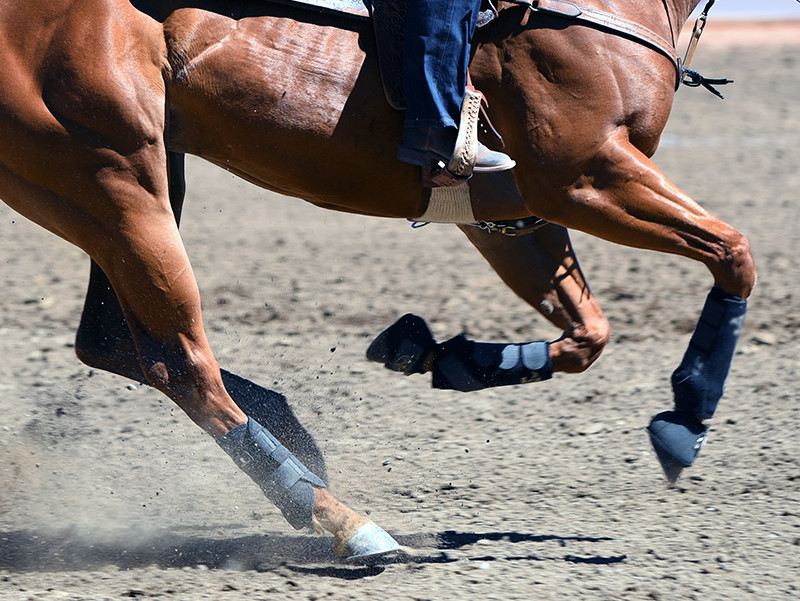A horse’s joints flex, bear weight, and absorb shock of various degrees. Regardless of age or discipline, wear and tear on a horse's joints can affect their performance. Proactive care and proper maintenance starting at an early age can help keep a horse moving fluid and comfortably throughout their career.
1. Provide Proper Nutrition Early
Proper nutrition can impact a horse’s musculoskeletal health and future performance as an athlete. Mares in foal or nursing supply all the vitamins and minerals their babies need for development. A weaned foal must also have a diet formulated to provide all the nutrients needed for their growing body. Nutrition has a large impact during those first few years of life that can help set a horse up for success down the road.
2. Put Fitness First
Prior to saddling your horse, it is important to take into consideration how fit your horse is. If your horse has had extensive time off or has had minimal riding each week lately you should not over exert them. Any time a horse is pushed passed their usual work load you run the risk of injury. Always make sure your horse is physically fit enough to perform the job you are asking them to do. Several days of light work is better than one day of heavy work. Old and young horses will benefit from daily exercise especially. Daily riding will help reduce stiffness in older horses and research has proven that light exercise on growing horses can help them to develop strong her bones and joints.
3. Address Inflammation Immediately
Inflammation is a major culprit in joint damage. If swelling is present, cold hose and ice the area to reduce heat and inflammation after initial injury. You can use compression therapy in applicable areas, such as no bow and standing wraps. Anytime a horse has excessive swelling around a joint, it is important to speak with a vet for guidance when providing a horse with anti-inflammatory medications. While NSAIDs work great to reduce inflammation, they can mask pain making it important to avoid riding/exercise until after the injury is evaluated by a veterinarian.
4. Get a Full Picture
Every horse is an individual and develops at its own pace mentally and physically. Deciding when to break a horse or ask for more in performance can be tricky without insight. X-rays can help influence your decision and also make you aware of areas of concern. X-raying key areas like fetlocks, knees, stifles and hocks can not only provide you with a clear picture of growth plates, but also show if there are any bone chips, spurs or damage to the joint. Knowing the exact status of a horse’s joint development can help prevent you from adding too much pressure before a horse is ready. In some cases, an extra six months to develop can make a big difference.
5. Balanced Shoeing
When considering joint health, it is very important to take your horses feet into consideration. It all starts at the ground. Keeping all horses, especially performance horses, on a strict a schedule keeps everything in line. “No matter what event or job a horse does feet play a major role in joint longevity. When the toe is too long it stresses the joints, while a horse stood up too much causes excessive concussion on the joints. Hind feet are just as important, too short of toe on hind feet causes major joint stress when sliding and stopping,” explains Tommy Wilson, performance horse shoer of 30 years. A horse that’s not shod level creates stress on the joints bearing uneven weight. Wilson goes on to say, “A horse, shod level and balanced, will stay sound for years to come. A horse shod incorrectly may continue to win for a little while but have a short career.” A good farrier and a regular schedule will help reduce unnecessary stress on joints helping them stay healthier, longer.
6. Ingredients that may lend support
Enhancing joint health and providing ingredients that support connective tissue, synovial fluid and cartilage will help support and promote long term health. Active ingredients such as glucosamine, hyaluronic acid, chondroitin sulfate, and MSM are important to help support healthy joints, tendons, and ligaments ensuring your horse is comfortable and in prime condition to compete. Glucosamine is the building block of chondroitin sulfate that plays an important role in the production and protection of joints. It also helps increase the production of new GAGs and therefore new cartilage, has also been shown to help inhibit free radicals and enzymes that break down cartilage. MSM helps to protect against damaging oxidative stress within the joints. Maintaining healthy joint fluid is extremely important and that is done with the help of Hyaluronic Acid (HA). Joint fluid acts as lubrication and shock absorption helping minimize stress on cartilage when it is healthy. Connective tissues of the body (skin, bones, cartilage, tendons, and ligaments) all contain Collagen. Collagen helps to nourish the joints and aid in recovery from exercise and injury.
While there are a few circumstances out of your control that contribute to joint issues such as genetics, unpreventable injuries, or defects, taking these tips into consideration and incorporating them into your program will help make a positive difference in your horses’ joint longevity. Balanced nutrition, rational exercise, and prompt treatment can help ensure a horse’s joints function comfortably past their prime.

